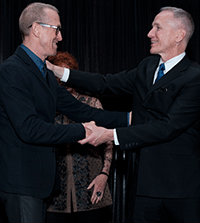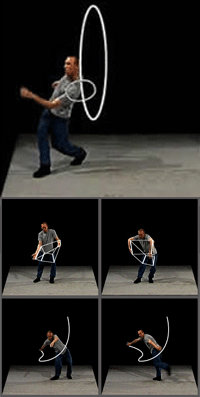|  |
Accent • Emphasis placed on one or more elements of dance
Welcome to our debut edition of Accent. Over the coming weeks leading up to our Season 38 Fall Series, Accent will invite you to explore the various elements of this program, through video, photography, essays, and additional resources.
Our goal with this new email publication is to bring you inside the dance, with fun and insightful guides to the works we’re passionate about presenting here at Hubbard Street.
|  |
|
|
|
| |

William Forsythe.
Photo by Dominik Mentzos.
|
| |

William Forsythe, left, with Hubbard Street Artistic Director Glenn Edgerton.
Photo by Robert F. Carl.
|
| |
|  |
William Forsythe, choreographer
Following our in-depth programs in recent seasons highlighting choreographers Jiří Kylián and Alejandro Cerrudo, Hubbard Street’s Fall Series is devoted exclusively to vanguard dancemaker William Forsythe.
Raised in New York and initially trained in Florida, Forsythe danced in New York City with the Joffrey Ballet and later the Stuttgart Ballet, where he was appointed Resident Choreographer in 1976. Over the next seven years, he created new works for the Stuttgart ensemble and ballet companies in Munich, the Hague, London, Basel, Berlin, Frankfurt am Main, Paris, New York and San Francisco. For twenty years beginning in 1984 until its closure in 2004, Forsythe also served as director of Germany’s Ballett Frankfurt.
In 2004, Forsythe established a new, more independent ensemble: The Forsythe Company, based in Dresden and Frankfurt am Main. The choreographer and his collaborators have received numerous awards, including four New York Dance and Performance “Bessie” Awards, and three Laurence Olivier Awards in the U.K. In Germany, he received a Distinguished Service Cross, the Ohio State University’s Wexner Prize, a Golden Lion at the Venice Biennale, the Samuel H. Scripps / American Dance Festival Award for Lifetime Achievement, and a Carina Ari Medal in Sweden.
In June 2015, Hubbard Street welcomed Forsythe to Chicago and presented him with a Spotlight Award in recognition of his invaluable contributions to the art form. “To put it simply,” said Hubbard Street Artistic Director Glenn Edgerton, “he has changed the face of dance.”
Click here to read more about William Forsythe.
|  |
|
| |  |
William Forsythe, philosopher
“Choreography and dancing are two distinct
and very different practices.”
Both in dance and the visual arts, Forsythe is broadly recognized for his dynamic creative voice. Over the course of his career, he has challenged preconceptions about ballet, extended its reach into the 21st century, and brought contemporary ideas to the classical arts. Forsythe, however, has not limited his innovation in dance to the theater; as he once noted, “choreography is about organizing bodies in space,” an approach which has sparked his creations in film and video, for web-based projects, plus installations, all bringing scientific and artmaking strategies deeply within his dance practice.
Click here to read Forsythe’s essay on “Choreographic Objects.”
|  |
|

“Nowhere and Everywhere at the same time,” an installation by William Forsythe.
|
| |
|
| |

Screenshot from “Movement Density,”
one component of “Synchronous Objects.”
|  |
| |

Choreographic object based on “One Flat
Thing, reproduced” as performed by
The Forsythe Company.
|
| |
|  |
William Forsythe, collaborator
“If dance does only what we assume it can do, it will expire.
I keep trying to test the limits of the concept of choreography.”
Forsythe has collaborated extensively with sports-scientists, philosophers, composers, architects, visual artists, and digital animators. Through these numerous cooperative projects, he has forged unique works which marry disciplines often assumed disparate, such as dance and geometry.
2009 marked the launch of “Synchronous Objects for One Flat Thing, reproduced,” a fully interactive website developed at the Ohio State University, and the pilot project for Forsythe’s Motion Bank: a new research platform focused on the creation of digital scores, completed in collaboration with guest choreographers.
“Synchronous Objects” takes you deep into the heart of a complex dance, allowing self-guided exploration of its organizational structures by translating and transforming them into new “objects” — new ways of visualizing dance that draw on techniques from disciplines ranging from 3-D mapping to industrial design.
Click here to explore the website “Synchronous Objects for One Flat Thing, reproduced.”
|  |
|
| |  |
William Forsythe, teacher
“One wants to give students everything one knows about one’s art, so one must go to the limit of one’s knowledge at every instance of one’s interactions.”
As an educator, William Forsythe is regularly invited to speak and give workshops at universities and cultural institutions. In collaboration with media specialists and educators, Forsythe has developed new approaches to dance documentation, research, and dance training.
Developed from 1994–99 in collaboration with the Zentrum für Kunst und Medientechnologie Karlsruhe (ZKM) and first released as an interactive CD-ROM, “Improvisation Technologies: A Tool for the Analytical Dance Eye” made a profound impact on the field of contemporary choreography. Its short video tutorials and detailed instructions for instantaneous dancemaking continue to be employed as teaching tools by professional companies, at dance conservatories, universities, postgraduate architecture programs, and secondary schools worldwide.
“Improvisation Technologies” introduces dance concepts based on “drawing” lines in space with the body, “room writing,” additive and subtractive compositional tools, choreographic reorganizations and much more. The series also includes video of solos demonstrating these “technologies” put to use, performed by Thomas McManus, Crystal Pite, Christine Buerkle, and Noah de Gelber.
Click here to browse and watch the videos from “Improvisation Technologies: A Tool for the Analytical Dance Eye.”
|  |
|

Stills from videos produced by ZKM
for “Improvisation Technologies.”
|
| |
|
| |

Hubbard Street Dancer Jacqueline Burnett
in “Quintett” by William Forsythe.
Photo by Quinn B Wharton.
|
| |
|  |
William Forsythe, in his own words
MCA Talk: William Forsythe
Wednesday, September 30 • 6–7:30pm
at the Museum of Contemporary Art Chicago
Tickets are available now for an intimate conversation with William Forsythe at the Edlis Neeson Theater in the Museum of Contemporary Art Chicago. Reserve your seats today for this rare, one-night-only opportunity setting the stage for our Season 38 Fall Series, October 15–18.
Click here to purchase tickets online
or call the MCA Box Office at 312-397-4010
$10 general admission
$8 MCA Members
$6 student tickets (subject to availability)
|  |
|
| |
| | |
Hubbard Street thanks Accent partner
Chicago Sinfionetta for helping make this publication possible.
Chicago Sinfionetta presents “Tap In. Turn Up.” October 3 and 5.
Hubbard Street patrons save $5 on tickets using code HSDC.
Discount available on Adult A, B and C level tickets.
Offer expires Oct 12, 2015. Discount not available at venues.
|
|
|
| |
|
|
|